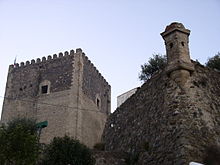Castelo de Vide is a mountain village in Alentejo. In 2011, it had about 3,400 residents. The romantic character of the village of Castelo de Vide, associated with its gardens, abundance of vegetation, mild climate and proximity to the Serra de São Mamede, made it known as "Sintra do Alentejo" (this designation is attributed to King Pedro V).
Understand[edit]


It is unclear when humans settled Castelo de Vide (kush-TEH-loo d(ih) VEE-d(ih), /kɐʃ.ˈtɛ.ɫu dɨ ˈvi.dɨ/), although establishment of a fortification helped fix a new population to the territory and, at the same, functioned as a strategic border fortress. In the 14th century, Afonso Sanches, son of king Afonso III, rebuilt the fortification walls, and his brother King Denis continued the task, with work completed during the reign of King Afonso IV.
Throughout the 14th century the settlement slowly expanded outside the castle walls. The southern flanks, with good southerly exposure and a gentle slope, allowed easy settlement, while the northern and western exposures expanded later due to wind and steep cliff faces. The growth of the settlement occurred along the main road leading to the castle, and followed the expansion of religious buildings outside the walls. This road bisected two sides of the hill and one side was occupied by a Jewish quarter inhabited by Jews expelled from Castile and Aragon.
In the 16th century, the settlement was dedicated to the cultivation of wine grapes, cotton, olives, fruits, and cereals, and raising cattle, while watermills were constructed along the ravines in Vide and Nisa. At the beginning of the 16th century, toward the end of King John III's reign, the wool industry became important in the region.
Visitor information[edit]
- 1 Posto de Turismo (Visit Castelo de Vide), ☏ +351 245 908 227, turismo@cm-castelo-vide.pt.
Get in[edit]
Reached by infrequent Rodoviária do Alentejo buses from Portalegre.
Get around[edit]
See[edit]

It's worth spending some hours here. You can see this before walking to Marvão if you are sleeping at the latter village. Alternately it is possible to return to Portalegre and get a bus to Marvão shortly after 18:00.
- 1 Castelo de Castelo de Vide (Castle). You can walk all around the 14th-century castle and the oldest part of the village without any charge.
- 2 Sinagoga de Castelo de Vide (Synagogue of Castelo de Vide), Rua da Judiaria. The synagogue in Santa Maria da Devesa still stands, and despite Portugal's expulsion of Jews in 1496 was used by Marranos as a religious sanctuary and school until the 16th century. Today it houses a small museum dedicated to Castelo de Vide's historical Jewish community.
Do[edit]
Buy[edit]
Eat[edit]
- 1 A Confraria, ☏ +351 245 905 106. Daily 12:30–15:00 & 19:30–22:00. Regional cuisine. €8-16.
Drink[edit]
Sleep[edit]
- 1 Casa Amarela TH & National Monument, Praça de D. Pedro V 11, ☏ +351 245 905 878, casaamarela@gmail.com. Check-in: 14:00–18:00, check-out: 09:00–12:00. Three-star, 11-room turismo de habitação ("housing tourism"), whose building dates from the 18th century. €73-109.
Connect[edit]
Go next[edit]

